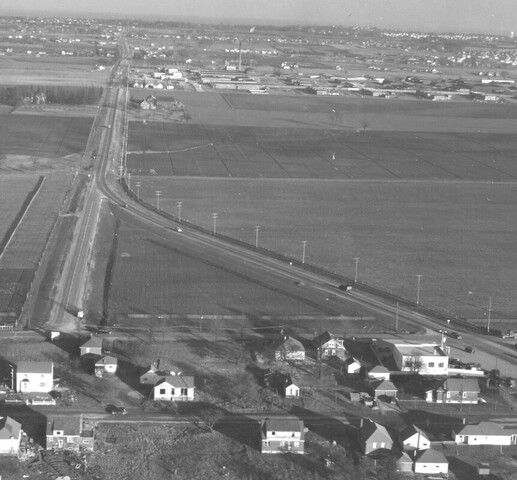
Golden Mile Industry Manufacturing
Rise of Industry
Eglinton Avenue East from Victoria Park Avenue, Scarborough, Ontario, 1949. Courtesy of the R. Schofield collection, Scarborough Archives
Billboard in Scarborough, April 1958. Photo by Harold Robinson / The Globe and Mail.
The Golden Mile Plaza, Scarborough, Ontario, c. 1961. Courtesy of Mimi Shulman.
Queen Elizabeth II visits the Golden Mile, Scarborough, 1959. Courtesy of Scarborough Archives.
Rise of industry
After the war, Scarborough Township had a problem. The small farming community could not pay its bills, and GECO; the company that had brought in a huge workforce and boosted the local economy, was closing. The Canadian government was willing to sell some of the GECO buildings and land to the township at a very small price. Oliver Crockford, the Reeve (Mayor) of Scarborough, agreed with plans to use some of the buildings for municipal offices and a library, and the rest – paired with a large lot to the east – could be developed for industry. He named the area “The Golden Mile” after an industrial area in England, and began pitching the area with promises of cheap land.
Manufacturing
Large businesses including General Motors, Volkswagen, Frigidaire, Thermos, and Svenska Kullagerfabriken (SKF) rapidly moved into the area and started manufacturing cars, toys, appliances, pharmaceuticals, cosmetics and candies. Soon, the area gained a reputation and younger companies relocated to the Golden Mile to signal their modern development and prosperity.
The rise in the workforce created the need for more local housing. In 1953, Oliver Crockford or “Mr. Scarborough” as he became known, announced that 10,000 new homes would be built to house the workers of the Golden Mile. Developers would advertise their homes by the proximity to the smokestacks – “Just think – you could walk to work!”
The Golden Mile Plaza
In the early 1950s, developers purchased land near Eglinton Avenue East to complete the suburban landscape by building a shopping center – the “Golden Mile Plaza”. It would become the largest shopping center in Canada, and the first to house a movie theatre and a bowling alley. The working class families of Scarborough, numbering around 100,000 at the time, could both live close to where they worked and also shop nearby for the products they helped make.
The plaza’s opening on April 8, 1954 was a huge community celebration – 2000 parking spots were filled to see acrobats, clowns, and an air show. Prize giveaways included 2000 pounds of coffee, and a draw for a 1954 Ford Skyliner.
The ultimate recognition of the area’s growing importance came in 1959, when after a tour of Sunnybrook Hospital, Queen Elizabeth II herself stopped at the Golden Mile Plaza for a ten minute visit.
Population boom
From 1951 to 1961, Scarborough’s population increased by 296%. While this was partly due to a change in immigration policy in 1946, which allowed families living in Canada to bring immediate relatives, including orphaned nieces and nephews, over from parts of Europe, the baby boom was a larger factor. In 1961, 41% of the Scarborough population was under 19 years of age.
Throughout the area, you can still see many postwar bungalows. The Canadian government gave housing grants to returning soldiers. The postwar economic boom, accompanied by the success of the Golden Mile, also made home ownership possible for the first time to many working class families. Hydro lines were installed, roads were widened and Highway 401 was built to link Scarborough to the rest of the city. Scarborough as a major suburb of Toronto was born, and Eglinton Avenue East became the major thoroughfare we know today.
Look for our Heritage Toronto plaque at the west corner of Hakimi and Eglinton Avenue East.

